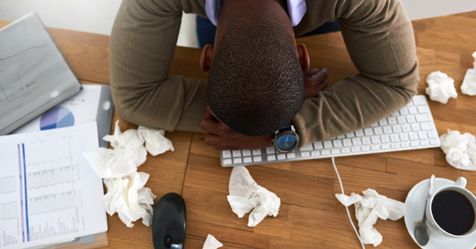As the northern hemisphere enters the winter months, you might hear coughs and sneezes echoing through your facility and notice higher employee absentee rates. Welcome to the cold and flu season.
Following two mild flu seasons due to COVID-19 lockdowns, the U.S. Centers for Disease Control and Prevention (CDC) considered the U.S. 2022–23 influenza season moderately severe, with an estimate of at least 31 million symptomatic illnesses, 14 million medical visits, 360,000 hospitalizations, and 21,000 deaths caused by influenza virus infection. The rate of influenza-associated hospitalizations was similar to hospitalization rates of four pre-COVID-19 seasons (2014–15, 2016–17, 2018–19, and 2019–20) and higher than all but one remaining season (2017–18) since the 2010–11 season.
The number of death certificates with influenza listed as an underlying or contributing cause of death during the 2022–23 season (9,697) was above the average number of influenza-coded deaths (8,530) during the five seasons preceding the COVID-19 pandemic (2015–16 through 2019–20) and three to 10 times higher than the number of influenza-coded deaths during the first two years
of the COVID-19 pandemic.
It remains to be seen whether the 2023–24 flu season will be mild or severe. The best plan of action is to adhere to your facility’s cleaning practices and protocols, and encourage your employees and building occupants to receive their flu vaccinations. Two infection control experts, Jordan Bastian, a senior infection preventionist with CloroxPro’s Clinical and Scientific Affairs team, and Jason Welch, a formulating chemist with Spartan Chemical Co., weigh in with their advice on preparing for the current flu season, and dealing with other common winter illnesses.
Facilities overrun with germs
Bastian and Welch listed rhinovirus, influenza, respiratory syncytial virus (RSV), and strep throat as the most common winter illnesses, with the addition of COVID-19 in recent years.
“Winter illness spikes for a few reasons but mainly because cold temperatures force people indoors for large gatherings,” said Welch. He explained that reduced airflow in buildings due to closed windows and doors can keep germs trapped inside.
“As activities and gatherings move inside, this creates an ideal environment for bacteria and viruses to spread on surfaces in shared spaces,” added Bastian. “More time inside means more of a chance for these germs to cause illness.” As people gather in facilities with reduced airflow, viruses and bacteria easily spread from person to person through respiratory droplets, contaminated surfaces, and the air. “When someone coughs, sneezes, or talks, germs spread and many end up on nearby surfaces,” said Bastian.
“As we spend more time inside and touch hot-spot items like doorknobs, light switches, chairs, and tables, we’re more likely to come in contact with germs and also contribute to their spread.”
Welch stressed that it isn’t necessarily the winter season that is responsible for the spread of germs, but rather the indoor conditions. “Germs spread in the same way, no matter what time of year it is,” he said. “They can be airborne, foodborne, and waterborne, and [spread] from potentially contaminated surfaces.”
Cleaning practices to the rescue
Bastian suggested that facilities take a three-step approach in their plan to prevent the spread of bacteria and viruses via contaminated surfaces:
- Ensure effective and efficient cleaning and disinfecting protocols are in place, including clear directions for who cleans and disinfects which spaces, at what time, and with what products.
- Make the most of your disinfectants by implementing a targeted approach. “I recommend doing this by focusing daily cleaning and disinfection efforts on high-touch surfaces such as tables, doorknobs, light switches, countertops, handles, desks, phones, keyboards, toilets, faucets, and sinks,” Bastain said. “Also focus on high-traffic areas—for example, classrooms, restrooms, break rooms, and frequently-used conference rooms.”
- Choose the right disinfectant for each space, making sure your selection includes products that are registered by the U.S. Environmental Protection Agency (EPA) to kill pathogens of concern. “I also recommend products that are ready-to-use as they eliminate the dilution step, making disinfecting more efficient, which is especially important in resource-constrained
environments,” said Bastian.
In busy public places, Welch recommends focusing on increased cleaning instead of disinfection. His reasoning is that disinfection only works in a controlled environment when the disinfectant is allowed to remain on the surface for the contact (also known as dwell) time listed on the product label. Following the recommended contact time is not always practical in a busy setting. Instead, frequent, quick cleanings will help remove germs on surfaces that are quickly re-contaminated.
“Keep adequate stock of cleaners that are suited for the surfaces being cleaned,” Welch said. “Most importantly [have] a well-trained staff [that knows] how to properly clean the facility.”
Clearing the air
In addition to focusing on surface pathogens, Welch and Bastian advised facilities to consider strategies to prevent the airborne spread of germs. Bastian recommends that facility managers
encourage respiratory etiquette, such as coughing and sneezing into a tissue or your elbow. Both stressed the importance of frequent handwashing and the use of hand sanitizer. “Keep soap and paper towel dispensers filled,” Welch said.
Don’t overlook your facility’s HVAC systems. “The best thing a facility can do is make sure their HVAC systems are up to date with maintenance and are turning over a proper air exchange,” Welch said.
The CDC recommends aiming for five or more air changes per hour (ACH). This can be achieved through a combination of air exchange through a central ventilation system, natural ventilation, and additional devices that provide equivalent ACH to existing ventilation.
Year-round protocols
As we enter flu and cold season, the experts agree that, ideally, facilities should not need to ramp up their cleaning and disinfection efforts.
“During flu season, times of increased illness, or during outbreaks, it is best to rely on your disinfection plan versus closing the facility or implementing extra cleaning and disinfection procedures,” said Bastian. “If you are using products effective in killing the virus or bacteria of concern, routine cleaning and disinfecting protocols should be sufficient.”
“Germ don’t take vacations,” said Welch. “Facilities should have a solid cleaning and maintenance program year-round. Think about a kitchen; should the kitchen relax its sanitation procedures because it’s a certain time of year? I hope not!”
Bastian said facility mangers can monitor the number of influenza cases in their area by reading updates from their local health departments along with the CDC’s flu activity and surveillance report, FluView, which it updates every week during flu season. Another CDC resource is the National Respiratory and Enteric Virus Surveillance System, NREVSS, a laboratory-based system that monitors circulation patterns of RSV, human parainfluenza viruses (HPIV), human metapneumovirus (HMPV), respiratory adenoviruses, human coronavirus, rotavirus, and norovirus.
Facility managers can use the information in these reports to ensure they have cleaning products on hand that are effective against the pathogens responsible for the illnesses in their area, Bastian said. They can also keep watch for illnesses among building residents and employees, who ideally have paid sick leave. Welch offered common-sense, yet often ignored, advice: “If you’re sick, stay home!”




